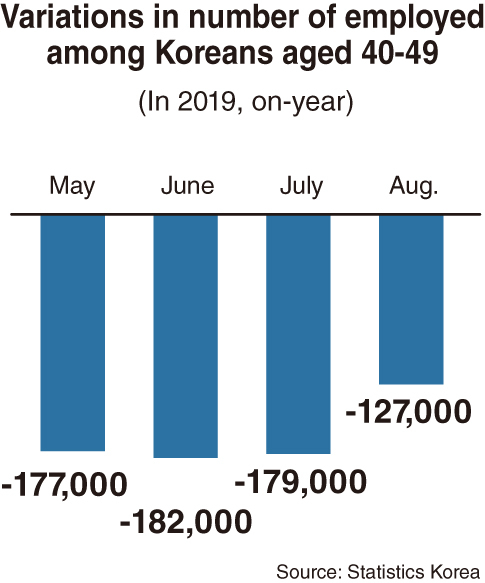[News Focus] Employment rate for Koreans in 40s falls for 19th consecutive month
By Kim Yon-sePublished : Oct. 1, 2019 - 15:06
SEJONG -- South Korea saw the number of employed people increase by 452,000 on-year to 27.35 million in August, the latest monthly figure from Statistics Korea.
But when broken down by generation, things are looking less rosy for middle-aged people in charge of households involving young children.
Those in their 60s dominated the increase in employment with 391,000, followed by those in their 50s with 133,000 and those in their 20s with 71,000.
On the contrary, the number of employed dropped among those in their 40s by 127,000. The figure for those in their 30s inched down 9,000.
Job insecurity among 40-somethings has risen over the past year, as a large portion of the self-employed suffered business closures (particularly in the retail sector) and early retirement pressures (particularly in the manufacturing sector) in the wake of economic slowdown.
But when broken down by generation, things are looking less rosy for middle-aged people in charge of households involving young children.
Those in their 60s dominated the increase in employment with 391,000, followed by those in their 50s with 133,000 and those in their 20s with 71,000.
On the contrary, the number of employed dropped among those in their 40s by 127,000. The figure for those in their 30s inched down 9,000.
Job insecurity among 40-somethings has risen over the past year, as a large portion of the self-employed suffered business closures (particularly in the retail sector) and early retirement pressures (particularly in the manufacturing sector) in the wake of economic slowdown.

The number of employed aged between 40 and 49 fell on-year for the eighth consecutive month. The number fell by 160,000 in January 2019 from the same month last year. Until August, the decreases for each month range between 128,000 (recorded in February) and 187,000 (in April).
The employment rate for those in their 40s stood at 78.5 percent as of August, down 0.2 percentage point from a year earlier. Further, their employment rate declined for the 19th consecutive month.
A Hansung University professor was quoted by a news provider as saying that “the number of economically inactive people is increasing among those in their 40s.”
People who are not economically active are not included in unemployment figures, which only include those who are looking for a job. This means the real employment rate among 40-somethings would be even lower and the real jobless rate higher, he said.

Statistics Korea data shows that the number of economically inactive 40-somethings has increased 27,000 on-year in the past few months. This is made more worrisome when considering that the total number of people in that age group is falling.
Meanwhile, a report from a commercial bank showed that the financial situation has worsened among households with breadwinners in their 40s.
A large portion of households headed by middle-aged people have suffered a sharp loss in income, Shinhan Bank said in a report. Out of the surveyed citizens aged 40-49 who reported a loss of income, 38 percent picked the loss of their jobs as the main reason for their deteriorating financial conditions.
Others pick pay cuts (29 percent) and business failures (13 percent).
According to the report, more than a half (55 percent) of the surveyed middle-aged households failed to prepare for a decline in earnings in advance.
And middle-aged workers face more layoffs, as manpower restructuring via voluntary redundancy programs is actively underway in the conglomerate-based manufacturing and financial sectors.
Enterprises’ main solution for difficulties has been to reduce costs through voluntary redundancy programs over the past decade or so. Early retirees in their 50s are usually paid a lump sum in addition to statutory severance pay.
Some of them used bonuses of 200 million won (166,000) or more start up their own small businesses, and some of the retirees, after taking huge bonuses, were found to have simply relocated to rival companies or subcontractors.
However, the present situation surrounding the voluntary redundancies has changed: The increase in bonus payments generally lags behind inflation, and while in the past it was workers in their 50s, now those in their early 40s have found themselves pressured to accept early retirement.
By Kim Yon-se (kys@heraldcorp.com)








![[Graphic News] More Koreans say they plan long-distance trips this year](http://res.heraldm.com/phpwas/restmb_idxmake.php?idx=644&simg=/content/image/2024/04/17/20240417050828_0.gif&u=)
![[KH Explains] Hyundai's full hybrid edge to pay off amid slow transition to pure EVs](http://res.heraldm.com/phpwas/restmb_idxmake.php?idx=644&simg=/content/image/2024/04/18/20240418050645_0.jpg&u=20240419100350)





![[From the Scene] Monks, Buddhists hail return of remains of Buddhas](http://res.heraldm.com/phpwas/restmb_idxmake.php?idx=652&simg=/content/image/2024/04/19/20240419050617_0.jpg&u=20240419175937)

![[KH Explains] Hyundai's full hybrid edge to pay off amid slow transition to pure EVs](http://res.heraldm.com/phpwas/restmb_idxmake.php?idx=652&simg=/content/image/2024/04/18/20240418050645_0.jpg&u=20240419100350)

![[Today’s K-pop] Illit drops debut single remix](http://res.heraldm.com/phpwas/restmb_idxmake.php?idx=642&simg=/content/image/2024/04/19/20240419050612_0.jpg&u=)